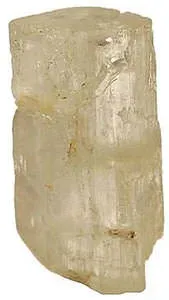 Hambergite is a mineral that was named after the Swedish mineralogist Alex Hamberg, who first identified the stone. Hambergite is a beryllium borate with hydroxyl and fluorine. It is not usually seen in jewelry (although it is durable enough to be worn as jewelry) because of its lack of color and brilliance. Collectors however, prize the stone. Hambergite is rare, especially in stones weighing over five carats. The largest known hambergite stone weighs 40 carats.
Hambergite is a mineral that was named after the Swedish mineralogist Alex Hamberg, who first identified the stone. Hambergite is a beryllium borate with hydroxyl and fluorine. It is not usually seen in jewelry (although it is durable enough to be worn as jewelry) because of its lack of color and brilliance. Collectors however, prize the stone. Hambergite is rare, especially in stones weighing over five carats. The largest known hambergite stone weighs 40 carats.
 Hambergite forms in flattened prismatic crystals. It rates a 7.5 on the hardness scale, has a dull to vitreous luster, and is transparent to translucent. It is usually given brilliant or step cuts. Hambergite ranges in color from colorless to white, yellowish, gray-white, or yellowish white. It can also have white streaks. The stone is brittle, with perfect cleavage.
Hambergite forms in flattened prismatic crystals. It rates a 7.5 on the hardness scale, has a dull to vitreous luster, and is transparent to translucent. It is usually given brilliant or step cuts. Hambergite ranges in color from colorless to white, yellowish, gray-white, or yellowish white. It can also have white streaks. The stone is brittle, with perfect cleavage.
 Hambergite has a high birefringence and a very low density. This is a very unique quality, which makes the stone easy to identify. Hambergite has very little fire. If not for its high birefringence, it would resemble
Hambergite has a high birefringence and a very low density. This is a very unique quality, which makes the stone easy to identify. Hambergite has very little fire. If not for its high birefringence, it would resemble ![]() quartz. When cut, hambergite can also resemble glass.
quartz. When cut, hambergite can also resemble glass.
 Hambergite was originally discovered in Norway, however the specimen found there were not of gem quality. Anjanabanoana, Madagascar, is now the best source of hambergite. Molo, in Myanmar, is also a noted source for small, good quality stones. However, hambergite can be found worldwide, in India, the Czech Republic, Norway, and the United States, in California.
Hambergite was originally discovered in Norway, however the specimen found there were not of gem quality. Anjanabanoana, Madagascar, is now the best source of hambergite. Molo, in Myanmar, is also a noted source for small, good quality stones. However, hambergite can be found worldwide, in India, the Czech Republic, Norway, and the United States, in California.